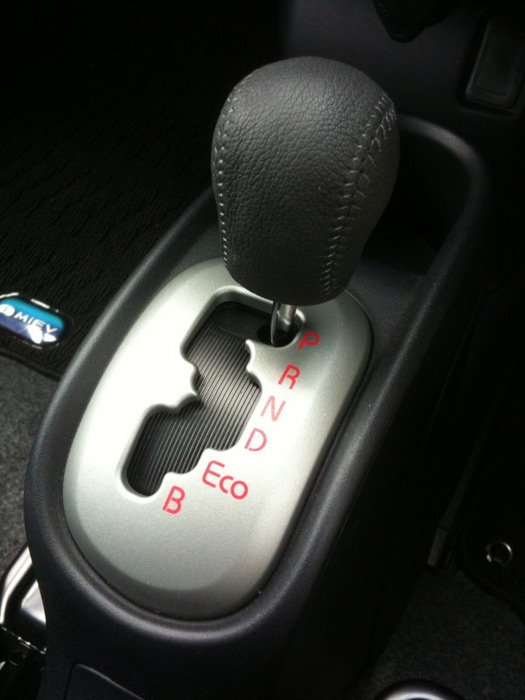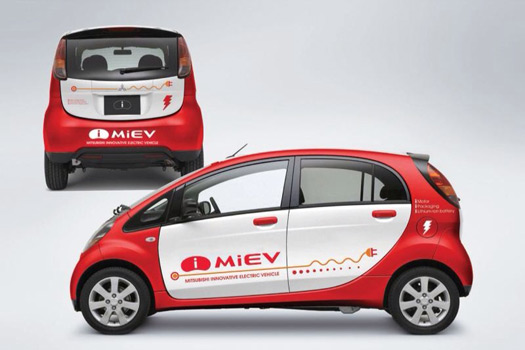
i-MiEV's shifter, featuring "Eco" and "B" (extreme energy-saving) settings
Beware of the turtle, they warned me. When the symbol lights up on the dashboard of the i-MiEV electric car, it’s time to recharge. But by then, unless you plan carefully, you’ll be far from home — and a charger.
“Range anxiety” is the fear of running out of juice, and probably the chief obstacle to people's acceptance of electric cars. We don’t like to plan our journeys so carefully. But this pod-like electric car, which has been lurking in the shadows of the more highly publicized Chevrolet Volt and Nissan Leaf, may alleviate that concern.
The i-MiEV stands for “Mitsubishi Innovative Electric Vehicle,” with “i” added on the model of “iPod.” It’s a real car — currently sold in Japan, due to be launched in the U.S. next fall — a small but legitimate four-seater that will be about $30,000, after tax breaks, so roughly the average price of cars currently sold in America. It has a range of about 80 miles per charge — if you don’t want to see the turtle — and a cost for each of those charges of about $3. That’s a quarter of the expense of running a car with 20 mpg fuel efficiency on a $3 gallon of gas.
Just as hybrids have moved from exotic to familiar in a decade, electric cars appear poised to enter everyday driving. How much they change our energy consumption has a lot to do with how little they change the rest of the way we drive. A century ago, electrics were as common as gasoline-powered cars; they may soon be again.
I spent several days with the i-MiEV — a right-hand-drive Japanese market version — charging it from an extension cord in my garage.
It was quiet and accelerated briskly enough. On the road, it felt a bit light and tinny, but not dangerous. I’ve driven a number of electrics, including the Volt, the electric Mini and even the old GM electric car that figured in Chris Paine’s film Who Killed the Electric Car?, and the i-MiEV compared well. The battery and motors tucked underneath produce the equivalent of only 63 horsepower, but don’t let that bother you, Speed Racer! Electrics are inherently zippy. All of their torque is instantly available; there are no gears.

i-MiEV profile and rear....
Like most hybrids, the i-MiEV has regenerative braking, which recaptures energy lost in stopping to recharge the battery. Its brake system felt much more refined than Mini’s experimental electric entry, which had a strange and clunky feeling.
The simple gauges are not so different from those on traditional gasoline-powered cars. There’s a speedometer and an indicator that runs from “Eco” green on the left to energy-greedy blue on the right. The gas-gauge equivalent marks battery level in bars that each represent three to four miles of range.
There are no gears, but the shifter offers regular, Eco, and B settings. The last is an extreme energy-saving position that maximizes use of regenerative braking.
Some quibbles: because the car is so quiet, the driver needs assurance that it’s actually running; a clearer light and chime or other sound would be useful. And the car seat’s heater switch has been placed so it can easily be turned on by accident, draining the battery.
The body comes from a so-called kei car Mitsubishi sells in Japan, one of a class of small vehicles that receive tax and other breaks. (For instance, owners of kei cars are not required to show proof of access to a parking spot.)
The i-MiEV is sold with a cable, neatly tucked in a little bag, that plugs into an aperture located where a traditional gas filler would be found. The cable connects to a conventional household cord (110v) or a heavier, appliance grade (220v) cord. It can charge on normal household current in about eight hours, on 220v in half that time and in special charging stations in only an hour, though these are few and far between. None currently exist in the U.S. and even Japan has only 167 such stations.
Not everyone has a garage with a plug in it, of course. Nor does electric necessarily mean green as long as most American electricity come from burning coal and oil. Mitsubishi figures that based on Japanese sources, the little car puts only one-third as much carbon into the atmosphere as a conventional counterpart.
How does Mitsubishi’s entry into the EV market stack up against its more famous competitors? The Chevrolet Volt, which is due out in November for about $40,000, feels much more like a conventional car than does the i-MiEV. It runs on electric for 40 or so miles, at which point a small gasoline engine switches on to run an electric generator. The Volt has the advantage, of course, of not being tied to electric outlets. The all-electric Nissan Leaf, which is also due out soon, claims a range of as much as 100 miles. But Nissan is also working to install charging stations. Toyota and Kia are working on small electrics about the size of the i-MiEV.
The intended role for this vehicle is as a commuter car for the 80 percent of the driving population that travels fewer than 40 miles a day. The i-MiEV could be a second car for many Americans, or a single car for those who might use rentals or car shares for the proverbial Thanksgiving visit to Granny.

...and the car in situ: it's currently on sale in Japan and will be offered to the U.S. market next fall
The i-MiEV is also among the electric vehicles being considered by companies that run fleets of cars. Mitsubishi placed i-MiEVs at the disposal of a California “Geek Squad” — Best Buy’s team of electronics installers who routinely dress in white shirts and narrow ties. The cars were painted in the black-and-white Geek livery, the mock police-car design previously used on the squad’s Volkswagen New Beatles.
That’s exactly the sort of strategy that could reassure consumers about electric cars.
Americans are restless and impatient people. But we have learned to guarantee our mobility by automatically plugging in our phones and laptops into outlets. The i-MiEV suggests that as more of us deal with basic electric cars, they will take on the appeal of the Prius. Changing, like charging, often moves slowly but steadily — like the turtle.


Comments [12]
08.19.10
10:28
09.05.10
08:16
09.08.10
12:08
09.08.10
12:11
09.17.10
10:54
11.17.10
03:09
12.04.10
03:08
12.24.10
07:07
01.24.11
10:22
02.08.12
12:45
Electric vehicles don't wear out brakes since they use regenerative braking that recharges themself about 10-15% on each drive. They also charge while going down hills without wearing the brakes.
An Electric vehicle is 4 times or more times efficient than a gas car, 2 times more efficient than a diesel. There is also a lot less maintanence.
03.19.12
11:20
05.21.12
10:12